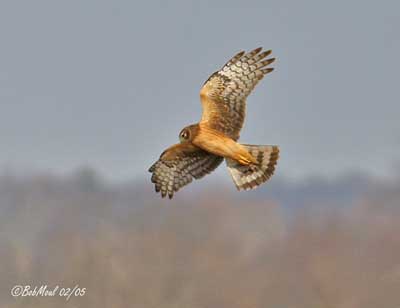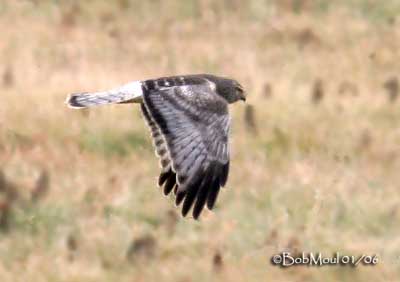
Fr: Busard d’Amérique
All : Hudsonweihe
Esp: Gavilán Sabanero
Ital: Albanella americana
Photographs by Bob Moul
Nature Photography
Text by Nicole Bouglouan
Sources:
HANDBOOK OF THE BIRDS OF THE WORLD Vol 2 by Josep del Hoyo-Andrew Elliot-Jordi Sargatal - Lynx Edicions - ISBN: 8487334156
A GUIDE TO THE BIRDS OF MEXICO AND NORTHERN CENTRAL AMERICA by Steve N. G. Howell, Sophie Webb - Oxford University Press - ISBN: 0198540124
BIRDS OF THE GREAT BASIN – by Fred A. Ryser - Univ of Nevada Pr -ISBN: 0874170796
HAWKS, EAGLES AND FALCONS OF NORTH AMERICA by Paul A. Johnsgard - Smithsonian Institution Press - ISBN: 1560989467
Bird Web (Seattle Audubon Society)
The Peregrine Fund – World Centre for Birds of Prey
What Bird-The ultimate Bird Guide (Mitchell Waite)
Northern Harrier
Circus cyaneus hudsonius
Accipitriforme Order – Accipitridae Family
BIOMETRICS:
Length: 43-52 cm
Wingspan: 100-120 cm
Weight: M: 350 g – F: 530 g
DESCRIPTION:
Formerly named “Marsh Hawk”, this beautiful raptor frequents the marshes, but its habitat also includes a great variety of landscapes.
There are two subspecies living on different continents:
Circus cyaneus cyaneus (see HERE) is found in the Old World.
Circus cyaneus hudsonius (here described and displayed) is a New World species.
The Northern Harrier adult male has most upperparts and head, neck and breast light to deep grey, with brownish-cinnamon wash.
On the upperwing, the coverts are grey with dark shafts. The flight feathers are similar, except the outermost primaries which are blackish.
The uppertail-coverts are white and the tail is grey with 5-7 narrow darker bars, and a broader terminal band.
On the underparts, the lower breast and the belly are white. We can see small brownish-grey spots on lower breast, body sides and upper belly.
On the underwing, the coverts are mainly white.
The bill is blackish with bluish base and orange-yellow cere. Eyes are yellow, as legs and feet.

The female is larger than the male and has different plumage.
She has dark brown to sepia head and upperparts. On the upperwing, we can see a pale buff wing bar, conspicuous in flight.
The uppertail-coverts are buffy-white and the tail is dark brown with 3-4 grey-brown bars and a narrow white terminal band.
The underparts are pale buff, streaked dark brown. The undertail is duller than above. The underwing is whitish and brown, with barred dark brown and greyish flight feathers.
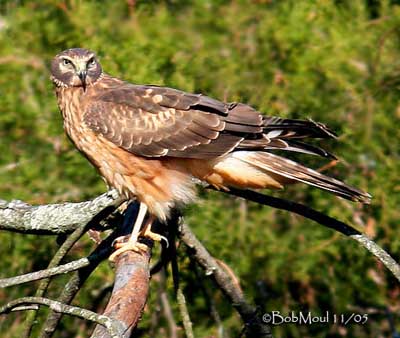
The juvenile resembles female but it has bright cinnamon underparts with dark brown streaks on upperbreast and flanks.
The underwing shows pale primary panel contrasting with darker secondaries.
On the upperparts, we can see pale-edged feathers on the upperwing. The uppertail-coverts are as in adult female.
The juvenile has dark brown eyes, and needs one year to gain the adult plumage.
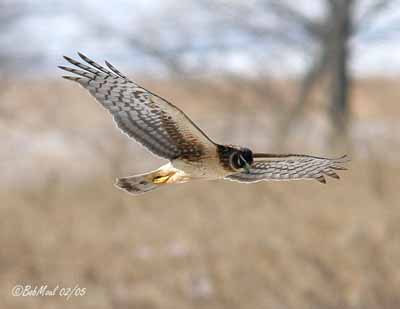
These birds show an owl-like facial disk made with specialized feathers. This facial disk probably allows the bird to hear the noises made by small mammals on the ground, and to detect them easily.
VOICE: SOUNDS BY XENO-CANTO
The Northern Harrier is mostly silent except around the nest. Rarely vocal, it can utter some rapid yelping chatter “kyeh-kyeh-kyeh…” with repeated and high-pitched notes.
During the breeding season, the female utters long, wailing “peee-e” whereas the male gives series of short “kek” during the flight displays.
The alarm call is a series of higher and rapid “ke” notes.
HABITAT:
The Northern Harrier frequents grassland, wet meadows, fresh and salt-water marshes, swamps, burned woodland and tundra.
In North America, it mainly frequents wetlands and young conifer plantations. It usually breeds at low elevation, up to about 300 metres.
This species can be found in alpine tundra and coastal marshes, in colder areas than other harrier’s species.
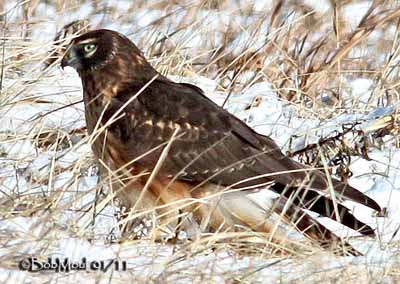
RANGE:
The race “Circus cyaneus cyaneus” occurs in the Old World, in Europe and N Asia to Kamchatka, and winters from Europe and NW Africa and S Asia to SE China and Japan.
The Northern Harrier, race “Circus cyaneus hudsonius” occurs in North America, southwards to NW Mexico and SE Virginia (USA). It winters in northern South America.
BEHAVIOUR:
The Northern Harrier feeds mainly on small vertebrates such as small mammals, from rodents to young rabbits and hares. It also takes birds, mainly passerines in open areas with low vegetation and wetlands.
During the breeding season, birds predominate with numerous chicks taken. It also catches large insects, reptiles, amphibians, bird eggs and carrion (in winter).
Once the prey is detected by ear and sight, the Northern Harrier often hovers briefly and drops straight down, or sometimes makes a “corkscrew” drop to the ground.
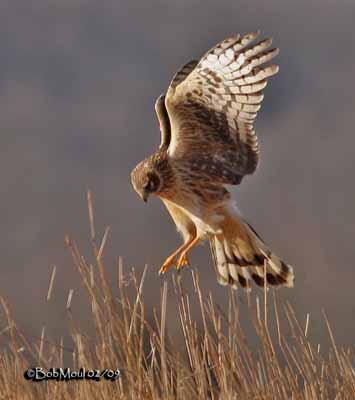
It often perches on the ground, but also on trees and rocks, fences and pylons. This species sleeps on the ground and outside the breeding season, numerous birds may gather at roosts, up to several tens.
The Northern Harrier performs spectacular flight displays often described as “sky-dance”. These displays begin before the pair- formation. The male performs several U-shaped dives, one after another, taking place within 100 metres of the ground. It draws a U by diving downwards and then pulls out of the dive, making a rounded curving course upwards.
At the peak, it almost stalls and makes a somersault or sideway turn, and dives again.
After the pair-formation, these flight displays are directed at the female, and performed close to her while she is hunting or perched.
Both sexes can perform these displays together. Other figure shows the male diving towards the female. She turns over on her back while flying, and holds the talons to the male. But the Northern Harriers never lock talons, as other species do. The mates can also soar together.
The aerial displays are accompanied with series of dry “kek” by the male.
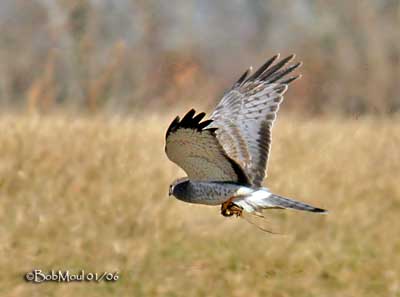
The Northern Harrier can be polygamous, with 2-3 female per breeding male. Some reports mention that the intensity of flight displays by the males attracts the largest harems.
This species is migratory in the northern parts of the range, whereas the populations of the rest of the habitat are only partially migratory or dispersive.
They migrate southwards from British Columbia and New Brunswick in Canada, to Central America, from Panama to N Colombia, Venezuela and sometimes Greater Antilles. They migrate in wide fronts.
FLIGHT:
When hunting, the Northern Harrier flies slowly, with wing beats interspersed with glides. During the flight displays, this raptor performs powerful flight with steep dives and equally steep ascents in quick succession.
In flight, the wings are rarely flat. The wing beats are fairly deep and easy.
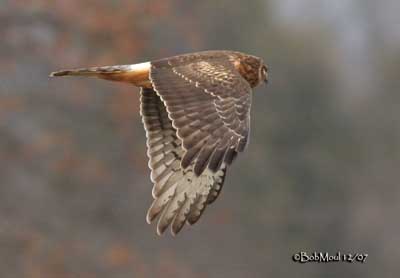
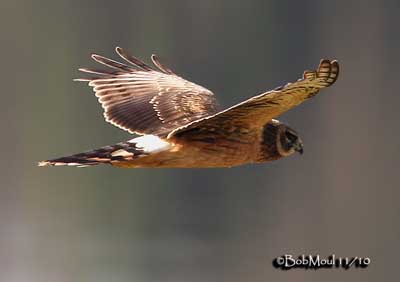
REPRODUCTION:
The breeding season peaks occurs in May in both North America and Europe.
The Northern Harrier nests on the ground in low vegetation, in dense grass or weeds or in shrubby area. It avoids the open land.
The nest is made with small sticks and grass, and usually built by the female.
She lays 3-6 eggs ate 1-3 days intervals. The clutch size depends on the food availability. A replacement clutch can be laid is the eggs are destroyed. The female incubates during about one month. After hatching, the chicks are brooded continuously during the first days. Only the male brings food. Later, the female hunts too, but close to the nest.
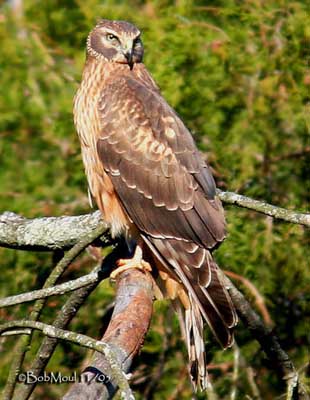
The male passes the prey to the female while flying. The female joins the male in the air. It flies above her and drops the food. In order to grab the prey in her talons, the female can slightly turn over on her back or swing the feet outside.
The chicks are covered in buffy-white down first, and later in buffy-brown. They fledge 29 to 38 days after hatching, and are fed during several weeks by adults. The young are sexually mature at 2-3 years, but about 30% breed at one year old.
Nest failure can occur when the polygamous male abandons the female in the middle of the season.
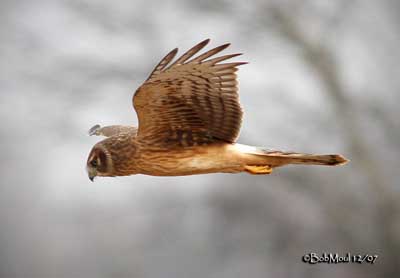
DIET:
The Northern Harrier feeds mainly on small mammals such as rodents, mice, voles and ground squirrels, and also young rabbits and hares. It takes birds in the open areas, from passerines to occasionally adult Galliformes and ducks.
It also consumes large insects such as grasshoppers and crickets, and takes reptiles and amphibians, and bird eggs. During winter, it can feed on carrion.
PROTECTION / THREATS / STATUS:
The Northern Harrier populations are probably fairly stables after serious decline in the 1970s. Currently, they still are slowly declining according to the range.
The main threats are the changes in the habitat for agriculture expansion, drainage of wetlands and reafforestation.
However, this species is evaluated at Least Concern.
